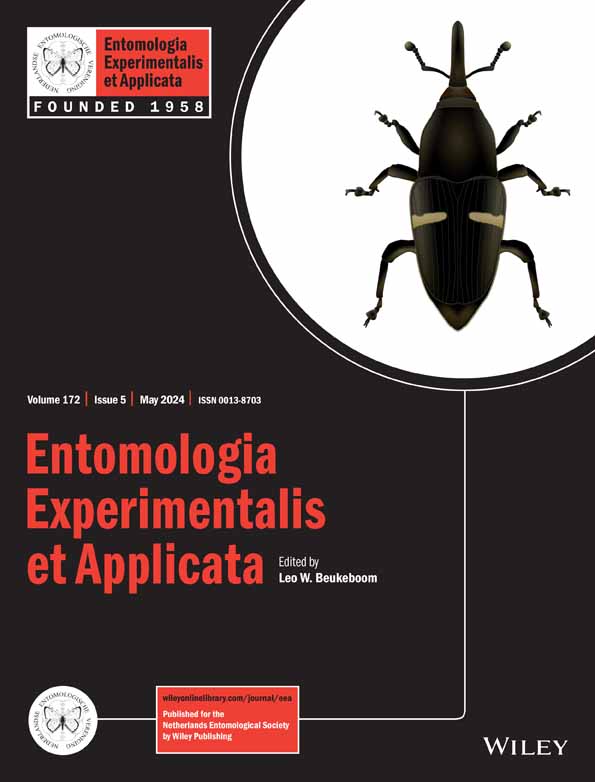Ver ítem
- xmlui.general.dspace_homeCentros Regionales y EEAsCentro Regional Tucumán - Santiago del EsteroEEA FamailláArtículos científicosxmlui.ArtifactBrowser.ItemViewer.trail
- Inicio
- Centros Regionales y EEAs
- Centro Regional Tucumán - Santiago del Estero
- EEA Famaillá
- Artículos científicos
- Ver ítem
Evaluation of Trichopria anastrephae performance as parasitoid of Drosophila suzukii and Zaprionus indianus, under controlled laboratory conditions
Resumen
Native parasitoids are potential tools for the biological control of invasive exotic pests, such as the frugivorous flies spotted-wing drosophila, Drosophila suzukii Matsumura, and African fig fly, Zaprionus indianus Gupta (both Diptera: Drosophilidae). Following biological invasions, the establishment of exotic species may be restricted, among other things, by their susceptibility to native or established natural enemies. The Neotropical-native pupal
[ver mas...]
Native parasitoids are potential tools for the biological control of invasive exotic pests, such as the frugivorous flies spotted-wing drosophila, Drosophila suzukii Matsumura, and African fig fly, Zaprionus indianus Gupta (both Diptera: Drosophilidae). Following biological invasions, the establishment of exotic species may be restricted, among other things, by their susceptibility to native or established natural enemies. The Neotropical-native pupal endoparasitoid Trichopria anastrephae Costa Lima (Hymenoptera: Diapriidae), although primarily associated with hosts of the genus Anastrepha (Tephritidae), has also been described to attack Drosophilidae. There are few studies on the interaction between parasitoids native to Argentina and D. suzukii and/or Z. indianus. The present work evaluates the parasitism of T. anastrephae on both species of drosophilids under controlled conditions. Ten larvae (L3) of each host species were exposed separately to a couple of adult T. anastrephae for 72 h (n = 10). For both control and parasitoid treatment, 10 larvae (L3) of D. suzukii and Z. indianus were placed in 10 flasks (repetition) at the L3 stage. Host emergence, the infestation degree index (DI), and the parasitism success rate (SP) were calculated. Drosophila suzukii and Z. indianus emergence differed significantly in controlled conditions being 41% higher for Z. indianus than for D. suzukii. The DI was 100% in D. suzukii and 38% in Z. indianus, and the SP was 48% both in D. suzukii and in Z. indianus. These findings indicate that the native parasitoid T. anastrephae has a high potential as a biocontrol strategy against D. suzukii. In addition, the efficiency of T. anastrephae against Z. indianus, an invasive frugivorous widely spread in the Neotropical region, was evaluated for the first time.
[Cerrar]

Autor
Funes, Claudia Fernanda;
Rendon, D.;
Saez, Julio Victor;
Allori Stazzonelli, Enzo;
Pastor, L.C.;
Gibilisco, Santiago Manuel;
Bouvet, Juan Pedro;
Maza, Noelia;
Kirschbaum, Daniel Santiago;
Fuente
Entomologia Experimentalis et Applicata : 1-7. (First published: 28 March 2024)
Fecha
2024-03
Editorial
Wiley
ISSN
0013-8703
1570-7458
1570-7458
Documentos Relacionados
Formato
pdf
Tipo de documento
artículo
Proyectos
(ver más)
INTA/2019-PD-E4-I101-001, Prospección, Prevención y Control de Lobesia botrana, Drosophila suzukii, HLB y Carpocapsa
Palabras Claves
Derechos de acceso
Restringido
 Excepto donde se diga explicitamente, este item se publica bajo la siguiente descripción: Creative Commons Attribution-NonCommercial-ShareAlike 2.5 Unported (CC BY-NC-SA 2.5)
Excepto donde se diga explicitamente, este item se publica bajo la siguiente descripción: Creative Commons Attribution-NonCommercial-ShareAlike 2.5 Unported (CC BY-NC-SA 2.5)


